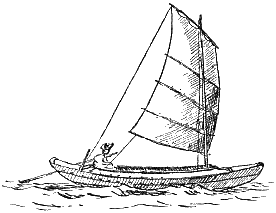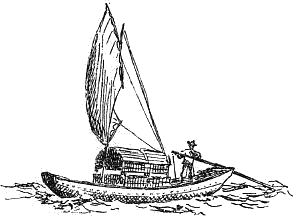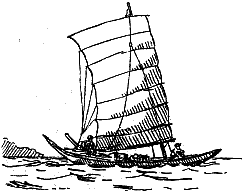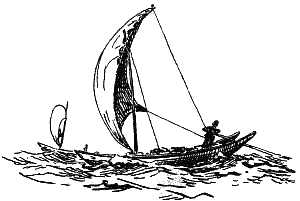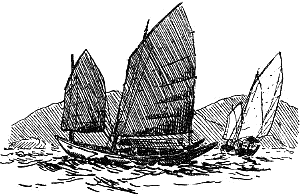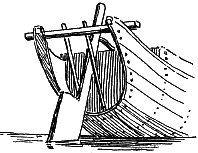JAPAN
In their use of mast and sail the
Japanese present one of their customary surprises. From
an island race of such valour, industry, and capacity,
boasting a civilisation two thousand years old, whose
history is filled with the records of fearless and
strenuous enterprise, and which is so advantageously
situated as is the Japanese, one would have expected
remarkable developments in nautical architecture, and in
maritime activity generally.
Yet in actual fact the national
high-pooped junk of Japan, the largest sea-going vessel
developed in the islands, was always of clumsy
construction, and had neither the quality of speed nor
that of ability to work to windward.
Although the Japanese have had
considerable intercourse with China, Korea, and Formosa
at various periods, it would appear that much of this was
conducted in Chinese junks, and for the rest they were
content to make slow voyages in their own archaic
vessels, the form and rig of which have never altered in
historic times.
It has been suggested that the
deliberate policy of seclusion which was adopted by the
rulers of Japan after the advent of the Portuguese at the
end of the sixteenth century, had much to do with the
small advance made by Japanese shipbuilders and seamen in
the art of building and equipping sea-going
vessels.
But it must be remembered that this
policy was only adopted at a comparatively recent date in
the nation's history, and in no way affected the early
maritime enterprise of the people. We have records which
show that certainly so late as 1592, when contemplating
an invasion of Korea, Hideyoshi entered into negotiations
with the Jesuits with a view to obtaining the loan of
some of the Portuguese armed vessels of the period,
which, small as we know them to have been, were in every
way superior to those of the Japanese. Nothing could give
more conclusive evidence of the unsuitable character for
long sea voyages of the Japanese vessel of the time
immediately preceding the period of seclusion.
The junk of to-day remains practically
identical with that of the sixteenth century, which in
turn had altered nothing from the vessels in vogue ten
centuries earlier.
This junk was a clumsy hut very
strongly constructed vessel of great bulk. It had a heavy
raked stem with low fo'c's'le, a high freeboard
amidships, and a lofty poop with a heavy rudder which
could be hoisted or lowered in a rudder trunk. Probably
no vessel ever built was more durable in construction or
more ingeniously or better finished as regards every
detail. Owing to the great beam and draught, it had large
carrying capacity, but the lack of length and sail-power
made it slow.
The rig consisted of a single heavy
mast setting one lofty but narrow squaresail, not
remarkable either for its set or for its excellence of
cut. The chief characteristic of hull, gear, and rigging
was excessive strength and cumbersomeness.
With the growth of modern commerce in
Japan there has come a great change over the face of the
Japanese mercantile marine. Simultaneously with the
formation of an efficient fleet of modern warships there
has grown up with remarkable rapidity a great fleet of
steam merchant ships, many of them of large tonnage and
first-class equipment; and in the management and handling
of these fleets the Japanese sailors have shown in a
remarkable degree that capacity for learning, and for
improving on what they learn, which has in other
directions been so eminently characteristic of the
nation. At the same time, on an indented coastline like
that of Japan, presenting sheltered waters and safe
harbours, it is inevitable that the sailing-vessel must
be of ever increasing use for the economical transport of
certain classes of cargo; and accordingly we find that in
the last thirty years the sailing tonnage of Japan has
steadily grown, as the water-borne commerce between the
different portions of the empire has
developed.
It was hardly to be expected that a
nation with such keen faculties as the Japanese possess
would, under the circumstances prevailing in the Pacific
at the end of the nineteenth century, continue to pin
their faith to so old and unsuitable a class of vessel as
the square-rigged junk of their ancestors. Thus it has
come about that the value of the fore-and-aft sail is now
fully appreciated in Japan. Not only are large numbers of
smart, handy little schooners now used in the coasting
trade, but the assistance of the fore-and-aft sail has
been invoked even on board the old-fashioned
junks.
Of the crowd of vessels to be seen
beating against a foul wind in any channel of the inland
sea, the majority will probably be still the old class of
junk with the square mainsail assisted by a fore-and-aft
mizensail on the poop and a fore staysail, or possibly
two, set before the mast. While formerly with main
squaresail alone the junk captains never attempted to
stay but were always compelled to wear ship, now, with
the addition of the mizen to bring the vessel's head up
and of the staysail to pay her off, they are able to stay
round with comparative facility, the gripe of the stern,
the shape of the underwater body, and the deep rudder all
being of material assistance.
It is in the schooners, however, that
modern Japan shows its fore-and-aft seamanship. These
little vessels follow in most particulars the general
features of the Pacific schooner, with which Japan has
become familiar from the visits of Canadian and Yankee
sealers. The two masts and main and fore sails are much
of a size; there is a longish jib-boom, and two or three
jibs are carried besides the fore staysail. The Japanese,
how-ever, have not gone in for topmasts, and pole-masts
are the rule; nor is the square topsail often seen. With
a pretty fiddle-head cutwater, the bow and waist are kept
fairly low, and the greatest freeboard is generally at
the quarters and poop, thus retaining in some measure the
main ideas of the old junk outline. In handling these
vessels they display all the fearlessness and competence
which are associated in the mind of Europe to-day with
the Japanese nature.
The Chinese lugsail has in some cases
been introduced in the schooner rig for the main and fore
sails, with once more a great gain in the direction of
flatness of set and general handiness over the old
square-sail.
In many of the smaller boats the gaff
mainsail is seen in combination with two fore staysails
both set inside the stemhead, an arrangement which is
probably peculiar to the Japanese islands.
The later developments in mast and
sail seem in every way more suited to their surroundings
than did the old junk. No more favourable conditions for
the production of small craft exist than in the beautiful
archipelago, which is second to none in the charm and
variety of its scenery and the multitude of its natural
havens. The old junk, with its clumsy bulk and
ineffectual rigging, seemed strangely out of place in the
midst of the ordered neatness of Japanese scenery, and
aroused in one's mind a constant sense of disappointment
and inappropriateness.
The clean schooner, modest and
efficient, graceful and capable, lying peacefully in some
quiet nook among the islets, or thrashing round a
tree-crowned point, her modernness toned by the Eastern
spell which hangs about her, seems to be totally in
harmony with the whole atmosphere of her surroundings,
and to form a notable instance of that power of the
sailing-boat to adapt herself to man's ways and to take
his character upon herself, in which she excels all
inanimate things and approaches so nearly to the
living.

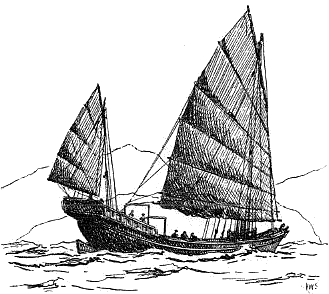
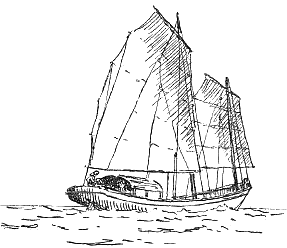 The
smaller sampans are innumerable in their varied designs,
differing as they do in each locality. In these smaller
boats the standing lug of cotton, with a bamboo yard and
boom, is often used, the steering being frequently done
with the after oar.
The
smaller sampans are innumerable in their varied designs,
differing as they do in each locality. In these smaller
boats the standing lug of cotton, with a bamboo yard and
boom, is often used, the steering being frequently done
with the after oar.